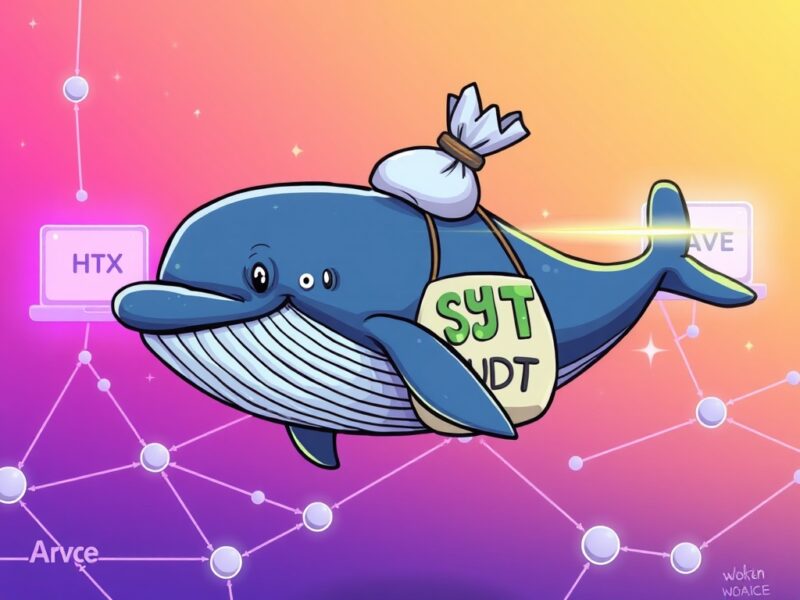USDT Whale Transfer: Unpacking the Massive $400M Move from HTX to Aave
0
0

BitcoinWorld

USDT Whale Transfer: Unpacking the Massive $400M Move from HTX to Aave
A monumental event has captured the attention of the cryptocurrency world: a massive USDT whale transfer. Whale Alert, the renowned blockchain tracker, recently reported a colossal movement of 400,000,000 USDT, equivalent to approximately $400 million, from the HTX exchange to Aave, a leading decentralized finance (DeFi) protocol. This significant transaction raises many questions about its purpose and potential market implications, drawing keen interest from investors and analysts alike.
What Exactly Happened in This Massive USDT Whale Transfer?
This particular USDT whale transfer involved an immense sum. On a recent date, a single transaction moved 400 million Tether (USDT) from HTX, formerly known as Huobi, directly to Aave. Such a substantial transfer immediately signals a high-net-worth individual or institution making a strategic move within the crypto ecosystem.
- Amount: 400,000,000 USDT
- Value: Approximately $400,000,000 USD
- Origin: HTX (formerly Huobi exchange)
- Destination: Aave (DeFi lending protocol)
- Source: Reported by Whale Alert
These large movements are often referred to as “whale” transactions because they involve amounts significant enough to potentially influence market dynamics. Therefore, understanding the context of this transfer is crucial for anyone following the crypto market.
Why Does a $400 Million USDT Transfer to Aave Matter?
The destination of this substantial USDT whale transfer, Aave, is particularly interesting. Aave is a prominent decentralized lending and borrowing platform. Users can deposit cryptocurrencies to earn interest or borrow against their crypto collateral. This move suggests several possibilities:
- Yield Farming: The whale might be looking to deposit the USDT on Aave to earn passive income through lending, taking advantage of the protocol’s interest rates. This is a common strategy in DeFi.
- Leverage: They could be preparing to use the USDT as collateral to borrow other cryptocurrencies, potentially to open new leveraged positions or manage existing ones. This allows for increased exposure.
- Strategic Positioning: The transfer could be part of a larger, multi-step strategy involving other DeFi protocols or future market plays. Such moves are often highly calculated.
Understanding these potential motivations helps us grasp the broader implications for the DeFi landscape. This isn’t just a simple transfer; it’s a calculated financial maneuver that could signal future activity.
What Are the Potential Market Implications of This USDT Whale Transfer?
A transaction of this magnitude can certainly capture market attention, even if it doesn’t always lead to immediate, dramatic price shifts. However, it can influence sentiment and liquidity within the crypto space.
- Increased Aave Liquidity: A $400 million deposit significantly boosts the available liquidity for USDT on Aave. This can make borrowing USDT easier and potentially impact interest rates on the platform, benefiting other users.
- Market Perception: Such large movements often spark discussions among traders and analysts, leading to speculation about market trends or upcoming events. Is this a sign of bullish sentiment, preparing for a long position, or a more cautious move?
- DeFi Confidence: A massive institutional or individual deposit into a DeFi protocol like Aave can be seen as a strong vote of confidence in the decentralized finance ecosystem’s stability and earning potential.
While direct market impact might not be immediate, the ripple effects on sentiment and liquidity within DeFi are worth monitoring. It underscores the ongoing institutional and large-scale participation in the sector.
Actionable Insights for Crypto Enthusiasts
For those closely watching the crypto space, significant events like this USDT whale transfer offer valuable learning opportunities and considerations.
- Stay Informed: Follow reliable blockchain analytics services like Whale Alert to track major movements. These can provide early signals of shifting market dynamics and potential trends.
- Understand DeFi: Familiarize yourself with how platforms like Aave work. Knowing the mechanics of lending, borrowing, and yield farming helps you interpret such transactions and their broader significance.
- Assess Risk: While these transfers can indicate confidence, remember that DeFi also carries risks. Always conduct your own research and understand the protocols before participating in any decentralized finance activity.
This event underscores the dynamic nature of the crypto market and the sophisticated strategies employed by large players. It highlights the importance of continuous learning in this rapidly evolving industry.
The recent $400 million USDT whale transfer from HTX to Aave is a powerful reminder of the substantial capital flowing within the cryptocurrency and decentralized finance sectors. Whether driven by yield generation, strategic positioning, or other complex financial maneuvers, such large-scale movements highlight the growing maturity and sophistication of the digital asset landscape. Monitoring these significant transactions provides crucial insights into the evolving strategies of major market participants and the health of the DeFi ecosystem.
Frequently Asked Questions (FAQs)
Q1: What is a “USDT whale transfer”?
A: A “USDT whale transfer” refers to a transaction involving an exceptionally large amount of Tether (USDT) moved by a single entity, often called a “whale,” due to their potential to influence market conditions.
Q2: What is HTX?
A: HTX, formerly known as Huobi Global, is a centralized cryptocurrency exchange platform where users can buy, sell, and trade various digital assets. It serves as a major gateway for many crypto investors.
Q3: What is Aave?
A: Aave is a leading decentralized finance (DeFi) protocol that allows users to lend and borrow cryptocurrencies. It operates on a peer-to-contract model, enabling users to earn interest on deposits or take out loans without traditional intermediaries.
Q4: What are the potential reasons for such a large transfer to Aave?
A: Potential reasons include seeking to earn interest through lending (yield farming), using the USDT as collateral to borrow other assets, or as part of a broader strategic investment or market play within the DeFi ecosystem.
Q5: Does this transfer directly impact USDT’s price?
A: While a single large transfer doesn’t typically cause a direct, immediate price change for stablecoins like USDT, it can affect liquidity on specific platforms like Aave and influence overall market sentiment regarding DeFi activity.
Q6: How can I track large crypto transactions like this?
A: Services like Whale Alert specialize in tracking and reporting significant blockchain transactions across various cryptocurrencies and networks, providing transparency into “whale” activities and market movements.
Did this analysis of the massive USDT whale transfer shed light on the intricate world of crypto whales and DeFi? Share this article with your network and spark a conversation about the latest developments in decentralized finance!
To learn more about the latest USDT whale transfer trends, explore our article on key developments shaping USDT whale transfer market dynamics.
This post USDT Whale Transfer: Unpacking the Massive $400M Move from HTX to Aave first appeared on BitcoinWorld and is written by Editorial Team
0
0
 Manage all your crypto, NFT and DeFi from one place
Manage all your crypto, NFT and DeFi from one placeSecurely connect the portfolio you’re using to start.







